DEFINING SOCAPEX
Parenthetical Definition
Synonyms: Soca, 19-pin, multiconductor cable, a large power connecting cable ranging from 25 to 500 feet.
Sentence Definition
Socapex, or Soca, is a large multiconductor power cable with 19-conductive prongs; it is often used in film, television, and stage lighting to connect lighting fixtures on stage to power distribution equipment off stage.
Expanded Definition
What is Socapex?
Socapex, also known as Soca, 19-pin and Multiconductor cable for its characteristic multi-prong connection design, is a large, multicore power cable containing 6 individual 20 A (Amp) circuits (Box 353; Cadena 67). The 19 pins on the male end of the cable are the conductive pieces that connect with the 19 holes on the female end.
The foundations of Socapex’s design is like a household extension cable with 3 prongs: consisting of 1 neutral, 1 live and 1 ground on the male end, that connects to the female end (see Fig 1). Socapex differs with its 19-pin design consisting of 6 neutral, 6 live, and 6 ground pins, with its 19th pin, used purely to aid alignment when connecting “the male end of the connector with a female receptacle” (see fig 2 for alignment and pin formation) (P3connectors.com).
Figure 1 Close up on the male and female ends of a household extension cable from:
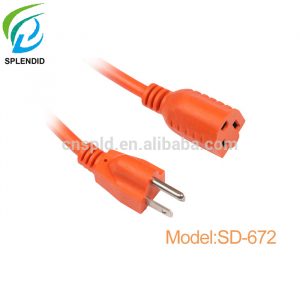
Figure 2 Close up of 19 pin configurations on the tail ends

Where is it Used?
This heavy-duty cable is often used in film, television, and stage lighting to connect lighting fixtures on a stage rig, a truss section with fixtures connected to power and data, to the power distribution centre off stage (see fig 3 and 4 for examples of a stage rig and power distro). There are two ratings this cable falls under #12 AWG (American Wire Gauge) for 20 A per circuit or #14 AWG for 15 A per circuit, which fulfills power demands for a variety of fixture types (Box 356).
Figure 3 Portable power distribution centre with 8 Socapex power outlets.
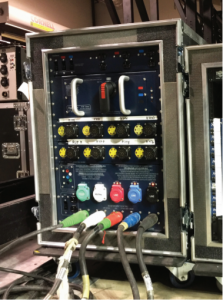
Figure 4 Stage Rig Diagram displaying hung lighting fixtures connected by a breakout cable to the Socapex cable from the power distro.
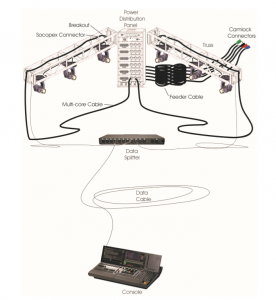
How Do You Use it?
To properly distribute power from Soca, you use a breakout splay. This attachment simply divides the 6 circuits carried within the cable into 6 individual outlets; that is why they often “breakout” into conventional household outlets, know as AC or Edison (see fig 6) (Cadena 68).
Figure 5 True1 power connection breakout splay
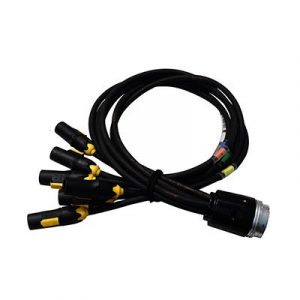
Figure 6 Edison connection breakout splay
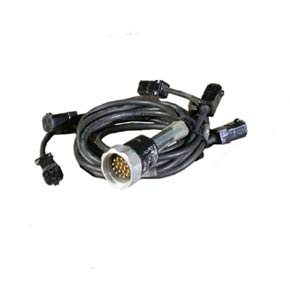
These 6 circuit breakouts can be adapted to a variety of connections such as Edison, a standard AC outlet (see fig 6); PowerCON, a twist-lock connection, and universal plug; True1 (see fig 5), the newest standard plug that offers voltages from 120 to 208 volts (Monk).
Example 1: Setting up 3 moving lightings on an 8ft piece of truss (based on fig 4).
An Elation 5 R requires 2.9 A at a standard 120 Volt service (see fig 7).
Figure 7 Elation 5 R Beam Fixture

There are 3 on one truss requiring 50ft of Socapex cable to reach the truss at height, 30ft on stage while also reaching the power distro below the stage, another 20ft.
To break out the 6 circuits of Socapex to service the 3 fixtures, you will use circuit 1, 2 and 3 to power each fixture with a standard 6 circuit, female end, Edison splay (see fig 6).
This fixture will use PowerCON adapters to connect the fixture to the Edison circuit provided by the Socapex breakout (see fig 8). These adapters work the same way as an extension cable just with the required ends: PowerCON to the fixture and Edison to the breakout splay.
Figure 8 PowerCON to Edison cable

In this case, 3/6 circuits will be used leaving 3 circuits, 4-6, available to be used by other fixtures, if added to the rig.
Precautions to Take?
A principle to follow when balancing power across Soca circuits is the 80/20 rule. This principle asks you to never put more than 80% of the total available amps on one circuit. For example, a 20 A circuit should never have more than 16 A on it at a time, leaving 4 A to allow room for the heat energy produced not to affect the conductivity of the cable. This practice is called de-rating current-carrying conductors based on the number of current-carrying conductors in contact with each other (Cadena 67).
Example 2: Calculating the load on a circuit (continuation from example 1 based on fig 4).
An Elation 5 R Beam lighting fixture draws 2.9 A to power all functions (“Elation Platinum Beam 5R”).
The breakout circuit we are using is 20A.
If we do not want to put more than 16A on the circuit, we can do simple math
20A – 2.9A = 17.1A available on this circuit.
Therefore, we have plenty of room to string together multiple fixtures on one circuit.
How many?
16A ÷ 2.9A = 5.5 therefore, we can put up to five 5R beam fixtures on one circuit, with a remaining 5.5A for current to fluctuate.
It is important to remember to balance how you distribute power across the circuits, as it is rare to put all of one type of fixture on one circuit; we often pair lights with nearby low drawing fixtures to minimize Socapex runs, usually no more than 2 to a truss line.
Conclusion
Overall, this cable offers a variety of ways to bring power to fixtures on a stage, in a theatre, or on a remote site with no infrastructure at all. While the overview presented here is very basic compared to the field, its principles are the same: Socapex carries power from a power distribution centre to a breakout splay that divides the current into useable circuits to service a group of lighting fixtures.
Works Cited
Box, Harry C. Set Lighting Technician’s Handbook: Film Lighting Equipment, Practice, and Electrical Distribution. Focal Press, 2010, www-taylorfrancis-com.ezproxy.library.ubc.ca/books/9780080928081.
Cadena, Richard. “Stage-Lighting Systems Overview.” Routledge, 2018; 2010;.
Monk, Elliott. Personal Interview. September 23, 2019.
P3connectors.com. (2019). Socapex Diagram for Wiring Circuits | 19 Pin Circular Lighting Connector. [online] Available at: https://p3connectors.com/Socapex-19-pin-circuit-drawings-wiring-diagram/ [Accessed 29 Sep. 2019].
Figures
Figure 1 “Extension Cable.” Alibaba. Nema Common Use Usa Bulk Extension Cord – Buy Bulk Extension Cord, Common Use Usa Bulk Extension Cord, Nema Common Use Usa Bulk Extension Cord Product on Alibaba.com. [online] Available at www.alibaba.com/product-detail/NEMA-common-use-USA-bulkextension_60762528720.html?spm=a2700.7724857.normalList.2.678c6cd87UH6q&s=p. Accessed 29 Sep. 2019.
Figure 2 “Socapex 19 Pin 1.5mm2 Cable.” Christie Lites. www.christielites.com/Socapex-19-pin-cable/230w4w36w155w657. Accessed September 30, 2019.
Figure 3 Portable power distribution centre with 8 Socapex power outlets from: Cadena, Richard. “Stage-Lighting Systems Overview.” p. 65, fig 3.13.
Figure 4 Stage Rig Diagram displaying hung lighting fixtures connected by a breakout cable to the Socapex cable from the power distro. From: Cadena, Richard. “Stage-Lighting Systems Overview.” p. 51, fig 3.1.
Figure 5 “True1 14/3 Break-in.” Christie Lites, www.christielites.com/true1-splays/228w2w17w148w1013. Accessed September 23, 2019.
Figure 6 “5-15 12/3 Edison Break Out.” Christie Lites, www.christielites.com/5-15-12-3-edison-splays/228w2w17w85w1017. Accessed September 23, 2019.
Figure 7 “Elation Platinum Beam 5R.” Christie Lites. www.christielites.com/elation-platinum-beam-5r/228w2w10w8w313. Accessed September 29, 2019.
Figure 8 “Stage Right by Monoprice 16 AWG NEMA 5-15p to PowerCON Connector 1.5FT.” Monoprice. https://www.monoprice.com/product?p_id=14557. Accessed September 29, 2019.
Link to Original
What is Socapex?
Link to Peer Review
Peer Review of “Socapex”
Docx File
301 Morgan Brandt 3 Definitions Revised








